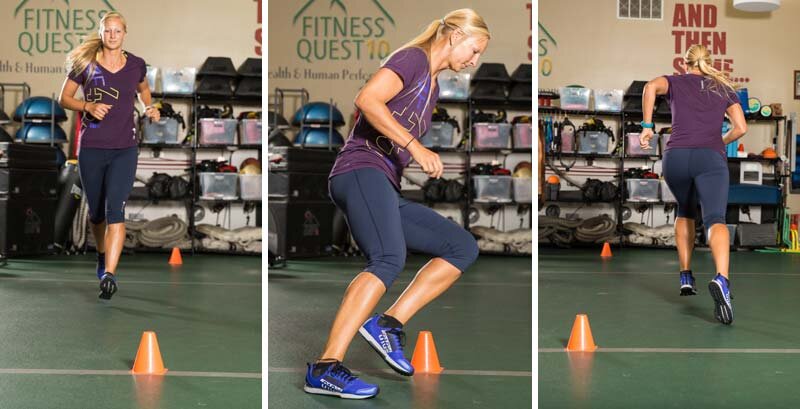Agility - Improve your Agility for Everyday Life.
Now we have looked at the health components of fitness, namely;
We will look in more depth at the skill-related components of fitness, starting with agility.
What is Agility?
Agility is our ability to rapidly change the position of our entire body[i]. It is how effectively we can change direction.[ii]
What do we use agility for?
Agility is often associated with sports. We see this in sports such as netball and basketball where players have to quickly change direction.[iii]
However, agility is also useful in everyday activities such as avoiding someone in the hallway, or changing directions to avoid stepping in dog poo or a puddle or gum. It can also be very handy with children in keeping them away from danger, such as a hot kettle, or just playing games with them in the yard.
Agility can also help with injury prevention as agility training increase control, balance and flexibility. It also teaches the body correct placement while moving quickly protecting the knees, shoulders and lower back. [iv]It also helps to strengthen our muscles and improve the resiliency of our connective tissue allowing it to rapidly shorten and lengthen.[v]
Photo by janulla/iStock / Getty Images
On top of this, agility training is also great for burning calories and improving your cardiovascular fitness.[vi]
How to improve agility?
As we discussed earlier, agility improvements appear to be mostly neurological in nature (i.e. we get better agility through changes in our nervous system). This means that improve our agility, we need to perform exercises that use agility.
These can include things like speed ladder agility drills and cone drills.[vii][viii]
Incidentally, due to its neurological basis, research has also found that agility drills can also improve our ability to think![ix]
Here are some useful agility exercises you can include in your training.
Cone Drills
Cones are great bits of kit for working agility. They are cheap, portable and should simply slide or fall over if you accidentally knock them. Try these with the cones 10 m apart and do 4-6 reps with 15-30 seconds rest.
To make things harder as you get more agile, you can add more reps.
Cone Shuttles
Run quickly from one cone to the next.
When you get to the cone, keep moving your feet and make a 180 degree turn around the cone.
Run back to the first cone.
Repeat.
https://www.acefitness.org/education-and-resources/lifestyle/blog/5041/benefits-of-agility-training-for-non-athletes/
Cone Forward Run to Back Pedal
Run forward for one cone to the next.
When you get to the second cone, back pedal to the first cone.
Repeat.
https://www.acefitness.org/education-and-resources/lifestyle/blog/5041/benefits-of-agility-training-for-non-athletes/
T-Drill
Set your cones out in a t shape.
State at the base of the ‘T’.
Run to the centre cone.
Then out to the right cone.
Then across to the left cone.
Back to the centre.
And back to the start.
Try touching the cones as you get to them to increase the challenge.
You can even time yourself and see if you can improve you time as your ability improves!
https://www.acefitness.org/education-and-resources/lifestyle/blog/5041/benefits-of-agility-training-for-non-athletes/
Conclusion
Agility is our ability to change directions quickly. While it is useful in many sports including basketball, netball and soccer, it is also useful in everyday life for avoiding obstacles, playing games with children and preventing injuries. To improve your agility, it is best to practice using your agility in activities such as cone agility drills. Give these a go and see how your agility improves.
[i] USDHHS (1996) cited in Corbin, C. B., Pangrazi, R. P., & Franks, B. D. (2000).
[ii] https://www.verywellfit.com/skill-related-fitness-components-4155209
[iii] Ibid.
[iv] https://www.merrithew.com/blog/post/2016-05-11/5-benefits-of-agility-training
[v] https://www.acefitness.org/education-and-resources/lifestyle/blog/5041/benefits-of-agility-training-for-non-athletes/
[vi] https://www.acefitness.org/education-and-resources/lifestyle/blog/5041/benefits-of-agility-training-for-non-athletes/
[vii] https://www.verywellfit.com/best-agility-drills-for-athletes-3120599
[viii] https://www.verywellfit.com/skill-related-fitness-components-4155209
[ix] APA Walker, T, B1; Lennemann, L, M1; Harrison, C, R2; Klein, R2; Doczy, E, J2 The Influence of Agility Training on Physiological and Cognitive Performance, Journal of Strength and Conditioning Research: March 2011 - Volume 25 - Issue - p S104-S105
doi: 10.1097/01.JSC.0000395745.95921.2f






